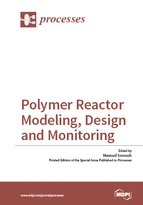Polymer Modeling, Control and Monitoring
A special issue of Processes (ISSN 2227-9717). This special issue belongs to the section "Materials Processes".
Deadline for manuscript submissions: closed (15 February 2016) | Viewed by 73828
Special Issue Editor
2. Department of Materials Science and Engineering, Drexel University, Philadelphia, PA 19104, USA
Interests: process systems engineering; polymer reaction engineering; electronic-level modeling of reactions; polymer membranes; renewable power generation and storage systems
Special Issues, Collections and Topics in MDPI journals
Special Issue Information
Prof. Dr. Masoud Soroush
Guest Editor
Manuscript Submission Information
Manuscripts should be submitted online at www.mdpi.com by registering and logging in to this website. Once you are registered, click here to go to the submission form. Manuscripts can be submitted until the deadline. All submissions that pass pre-check are peer-reviewed. Accepted papers will be published continuously in the journal (as soon as accepted) and will be listed together on the special issue website. Research articles, review articles as well as short communications are invited. For planned papers, a title and short abstract (about 100 words) can be sent to the Editorial Office for announcement on this website.
Submitted manuscripts should not have been published previously, nor be under consideration for publication elsewhere (except conference proceedings papers). All manuscripts are thoroughly refereed through a single-blind peer-review process. A guide for authors and other relevant information for submission of manuscripts is available on the Instructions for Authors page. Processes is an international peer-reviewed open access monthly journal published by MDPI.
Please visit the Instructions for Authors page before submitting a manuscript. The Article Processing Charge (APC) for publication in this open access journal is 2400 CHF (Swiss Francs). Submitted papers should be well formatted and use good English. Authors may use MDPI's English editing service prior to publication or during author revisions.
Keywords
- polymers
- mathematical modeling
- control
- monitoring
- optimization
- simulation
- safety analysis






